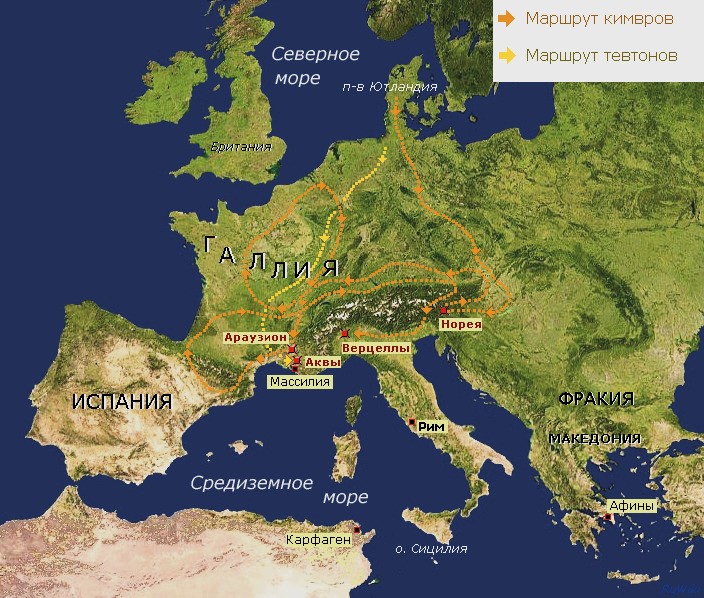Cimbrian War
The Cimbrian War (Latin: Bellum Cimbricum, 113-101 BC) was a conflict between the Roman Republic and the Germanic tribes of the Cimbri, Teutones, and several Celtic tribes in the late 2nd century BC.
Causes of the War:
From the Roman perspective: the territorial expansion of the Roman Republic into the North and Gaul led to clashes with the migrating Cimbri, Teutones, and Tigurini tribes moving southward.
From the barbarians perspective: according to the accounts provided by the Roman historian Florus in his work "Epitome of Roman History" (Book I, Chapter III, Section 3), "The Cimbri, Teutones, and Tigurini, expelled from the coastal parts of Gaul by the ocean that flooded their lands, sought new places throughout the world. Cut off from Spain and Gaul, they moved towards Italy...". These were the reasons for the barbarians' war with Rome. This war is considered the first conflict between the Romans and the Germanic tribes.
Cimbri (Latin: Cimbri) were an ancient Germanic tribe that inhabited the central and northern parts of the Jutland Peninsula until the end of the 2nd century BC. Along with the Teutones, Tigurini, and Ambones, who also lost part of their territory due to flooding, the Cimbri moved southwards to Italy.
Teutones (Latin: Teutoni) were an ancient Germanic tribe that lived on the western coast of Jutland, in the lower region of the River Elbe (east of the lower Elbe) and the Danish islands. At the end of the 2nd century BC, they, along with the Cimbri, Tigurini, and Ambones, who lost part of their territory due to flooding, moved southwards to Italy.
Tigurini (also known as Helvetii, Latin: Helvetii) were a large Celtic tribe residing in the northwestern part of modern-day Switzerland (known as Helvetia to the Romans). Some of the Helvetii, along with their allies the Cimbri and Teutones, participated in the campaign towards the south, into Italy, and were defeated by Gaius Marius.
Ambones (Latin: Ambrones) were a Celtic tribe that inhabited the territory of modern-day Switzerland (Helvetia) during the invasion of the Germanic tribes, the Cimbri, and Teutones. The Ambones, along with their allies, the Cimbri and Teutones, were defeated by Gaius Marius. The exact location of the Ambones' territory is uncertain.
The Cimbri and Teutonic allies were defeated by Gaius Marius. It is not known exactly where the Ambrons lived.
 Map of the Cimbrian War and its main battles
Map of the Cimbrian War and its main battles
Course of the war
After subduing several Celtic tribes in Upper Danube, the Teutones and Cimbri continued their advance towards Italy.
The Romans and the Cimbri with the Teutones met face to face for the first time in the northeastern Alps when they invaded Noricum (modern-day Austria) in 113 BC.
There, they began plundering and ravaging the tribes and cities allied with Rome.
The Senate dispatched a Roman army led by Consul Gnaeus Papirius Carbo against them.
Carbo, in order to block their path from Noricum to Italy, occupied the mountain passes in the northeastern Alps. After unsuccessful negotiations, a battle ensued, which the Romans lost.
After the battle, the Cimbri continued their westward journey.
Passing through the lands of the Helvetii, they were joined by the Tigurini and Taurisci tribes, and the Cimbri crossed the Rhine and entered Gaul.
There, in several battles over the course of several years, they defeated the Romans (109, 107, and 105 BC).
In 105 BC, in the Battle of Arausio (Aravsio), a Celtic settlement on the left bank of the Rhone, the Teutones and Cimbri managed to completely annihilate two Roman armies commanded by Proconsul Quintus Servilius Caepio and Consul Gnaeus Mallius Maximus. As a result, the Romans were unable to halt the advance of the Germanic tribes from Gaul into Italy.
Roman historians Tacitus and Orosius report that the Romans lost around 80,000 soldiers and 40,000 servants in the two armies, which exceeded the losses suffered by the Romans in the Battle of Cannae against Hannibal. Modern historians believe that such high losses among the Romans can be explained by the fact that the Germans first pressed and then pushed both Roman armies into the Rhone River.
However, the Romans were fortunate because after this victory, the Germans decided against an immediate invasion of Italy. They ravaged the vulnerable Norbon Gaul, as all the Roman forces capable of defending it had been destroyed, and then they invaded Spain, where the Celtiberians (a group of tribes in central and northern Spain and Portugal before Roman conquest) forced them to return to Gaul.
All this provided a temporary respite for the Romans.
The victories of the Germanic tribes over Roman armies for several years caused terror cimbricus ("Cimbrian terror") among the inhabitants of Rome.
Amidst these tragic events, the Romans elected a young and promising, successful military commander, Gaius Marius, as consul in 104 BC.
Marius made good use of the time while the Cimbri and Teutones ravaged Gaul and Spain by implementing a military reform of the Roman army (for more details, refer to the article on Gaius Marius) and preparing it for battle against the barbarians.
Finally, in 102 BC, the combined forces of the barbarians set off for Italy in three columns. The Teutones and Ambrones took the shortest route along the coast, while the Cimbri went through Noricum, bypassing the Alps. The Tigurini lingered in the Alpine foothills and dispersed after hearing about the defeat of their allies.
Roman historian Lucius Annaeus Florus informs us about this method of the Germanic attack on Rome in his work "Epitome" 1.38.
The first ones that Gaius Marius encountered were the Teutones and Ambrones as they were moving along the coast from Gaul to Italy.
Marius managed to occupy a favorable position near the town of Aquae Sextiae (today located north of the present-day city of Marseille), where the battle took place in the summer of 102 BC. The Romans emerged victorious.
Ancient historians differ in their assessment of the losses suffered by the barbarians: Plutarch writes about approximately 100,000 dead and captured; Velleius Paterculus reports 150,000 people; Tacitus mentions 200,000 killed and 90,000 taken prisoner.
The Romans either killed or captured the Teutones. The leader of the Teutones, Teutobod, was captured and later became an "honorary" prisoner paraded through the streets of Rome during a triumph.
The second column, the Cimbri, who were bypassing the Alps to reach Italy, was attempted to be stopped by the second consul of 102 BC, Quintus Lutatius Catulus, who positioned his forces in the northeastern Alps. Catulus failed to halt, let alone defeat, the Cimbri and withdrew to the southern bank of the Po River, leaving the Cimbri to ravage northern Italy between the Po and the Alps. Thus ended another year of the Cimbrian War.
In 101 BC, Gaius Marius, once again elected consul, united his forces with those of the proconsul Catulus and crossed the Po River once more, where he forced a decisive battle upon the Cimbri.
At first, the Cimbri evaded him, but upon learning the fate that befell their Teutonic allies, they agreed to engage in battle.
The battle took place on July 30, 101 BC, at the Raudine Plain near the city of Vercellae (modern-day Vercelli, Italy).
Catulus positioned himself with his army in the center, while Marius took the flanks with his forces.
The Cimbri formed a large square, placing all their cavalry on the right flank.
In the end, the Romans emerged victorious, but Catulus and Marius disputed who dealt the decisive blow to the Cimbri.
Two out of the four Cimbrian leaders, Boiorix and Lugius, were killed in the battle, while the other two leaders, Claodicus and Caesorix, were captured.
The wives of the Cimbri fought desperately and took their own lives, as did the women of the Teutones.
Similarly to the casualties in the Battle of Aquae Sextiae, ancient authors differ in the number of enemy casualties and prisoners: Florus reports 65,000 dead; Velleius Paterculus mentions 100,000 dead and captured Cimbri, while Plutarch states 120,000 dead and 60,000 captured enemies.
 Gaius Marius. Antique bust. Glyptoteca. Munich
Gaius Marius. Antique bust. Glyptoteca. Munich
Results
Under the leadership of Gaius Marius, the Romans were able to defeat the invading tribes of the Cimbri, Ambrones, and Teutones.
Many Cimbri and Teutones perished in the battles, and many were sold into slavery. Ancient authors did not come to a unanimous opinion regarding the exact number of enemy casualties in the battles, providing different figures.
As a result, the Teutones as a tribe disappeared, although their name continues to be used as a general term for modern Germans, and a small portion of the surviving Cimbri retreated to the north toward the North Sea, where information and mentions of them vanish from historical sources after the 1st century AD.
The Romans encountered Germanic tribes again only during the time of Gaius Julius Caesar, almost 50 years later, during his conquest of Gaul known as the "Gallic Wars."
 Artist Alexandre Gabriel Descamp (1803-1860). Painting "The Defeat of the Cimbri" (1833). Louvre, Paris, France
Artist Alexandre Gabriel Descamp (1803-1860). Painting "The Defeat of the Cimbri" (1833). Louvre, Paris, France
Related topics
Roman Republic, Gaius Marius, Gaius Julius Caesar
Literature
Ancient authors:
- Lucius Annaeus Flor. "Epitomes". Book I. 38.;
- Strabo. Geografiya (7.2.2, 5.1.8);
- Titus Liivius, " The History of Rome from the foundation of the city "(books 63, 65, 67, 68);
- Julius Caesar “The Gallic Wars” (1.7, 1.12—13, 2.4, 7.77);
- Appian, " On the Wars with the Celts "(fr. 13);
- Granius Licinianus (fragm., book 33); 67;
- P. Orosius . "History against the Gentiles". (5.16.);
- Plutarch. "Comparative biographies. Gaius Marius”;
- Vellei Paterkul. "Roman History". (2.12.).
Modern literature:
- Die Germanen: Ein Handbuch / Hrsg. B. Krüger. 2. Aufl. B., 1976–1983. Bd 1-2; Shchukin M. B., Eremenko V. E. K probleme kimbrov, Teutonov i keltoskov: tri zagadki [On the problem of the Cimbri, Teutons and Celtoscientists: three riddles]. 1999. No. 34; Kulakov V. I. Istoriya Prussii do 1283 g. [History of Prussia before 1283] Moscow, 2003, pp. 246, 247.


